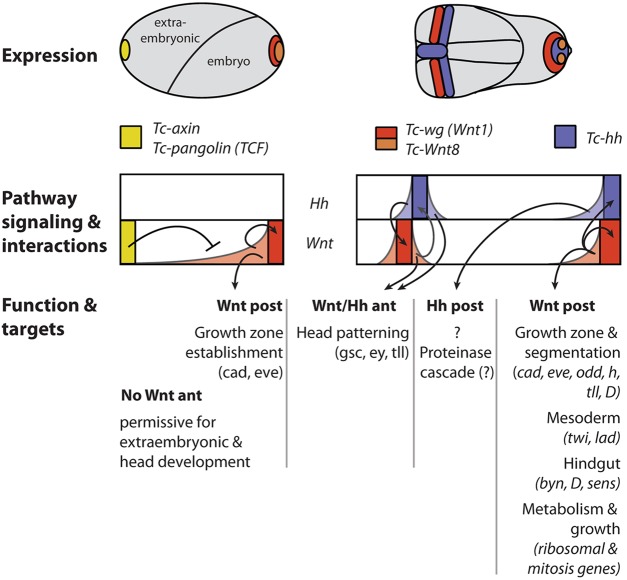Fig. 7.
Summary of early Wnt and Hh signaling functions in head and GZ. The Wnt/β-catenin pathway has an early function in axis formation (left). During blastoderm stages, posterior Wnt/β-catenin signaling is required for GZ establishment and posterior patterning. Anterior repression of Wnt/β-catenin signaling is required for anterior development, with the extraembryonic serosa and the anterior embryo being most sensitive to elevated Wnt activity. Hh signaling does not appear to play a role at this stage. At the germ rudiment stage (right), posterior Wnt signaling maintains its own activity and initiates Hh signaling in the GZ. At the same time, adjacent stripes of Tc-wg and Tc-hh expression arise in the head anlagen, with Hh signaling being required for the initiation of Tc-wg expression. Later, mutual activation maintains this boundary. At this stage, we detected only a few target genes for both pathways in the head. The posterior Hh target gene set is largely non-overlapping with the Wnt set but its function remains elusive. Posterior Wnt/β-catenin signaling plays a central role in posterior development. First, it activates genes required for pattern formation in the GZ. This includes segmentation of the ectoderm, the formation of the mesoderm and the hindgut. Second, the expression of genes required for protein metabolism is enhanced by Wnt/β-catenin signaling. Finally, genes required for cell division are regulated by Wnt/β-catenin signaling. Hence, Wnt/β-catenin integrates patterning, metabolism and growth. Note that later functions of these pathways (such as parasegment boundary formation) are not depicted in this scheme and that the expression of further Wnt ligands has been omitted for simplicity. See text for further details. ant, anterior; post, posterior.

